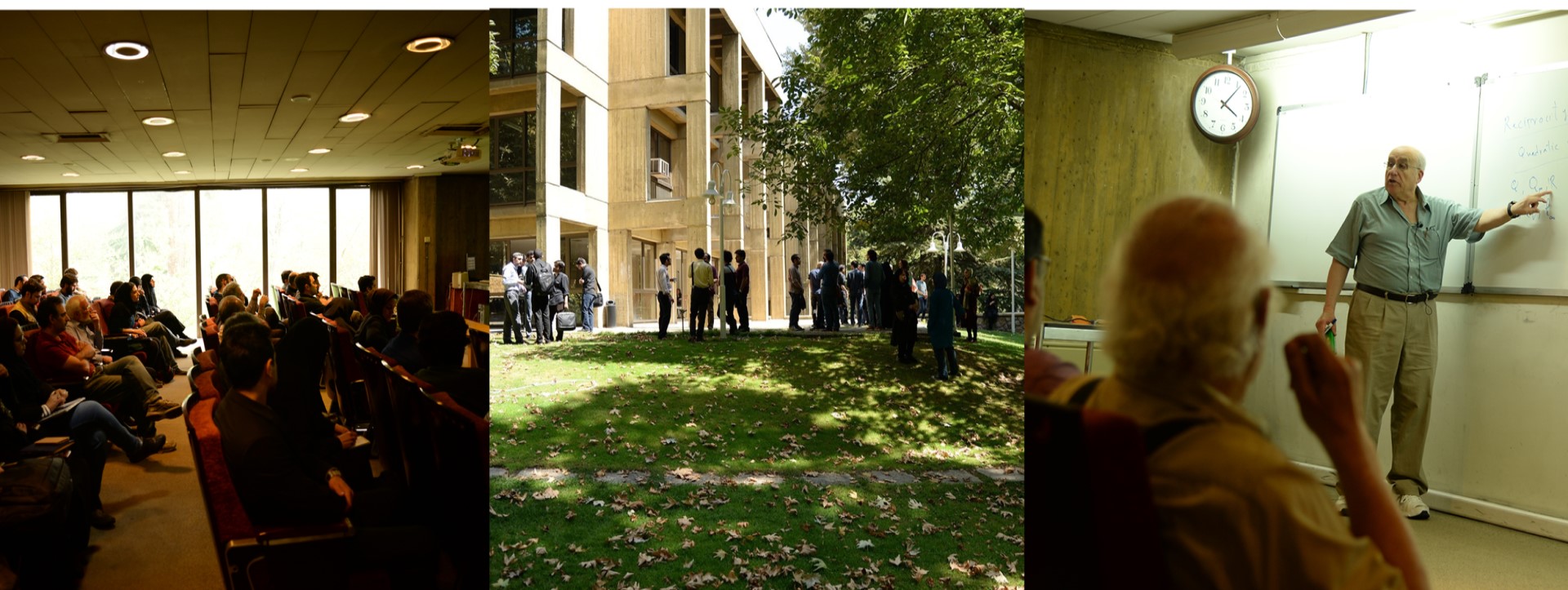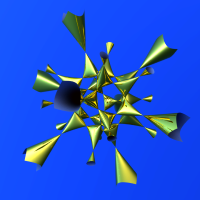
IPM Algebraic Geometry Seminar
IPM is holding a biweekly zoom Algebraic Geometry seminar for Winter/Spring 2025.

Where: Zoom
Meeting ID: 908 611 6889
Passcode: 13440 × the number of lines on a cubic surface
Seminar mailing list: google group
Poster: here
Talks
Speaker: Artan Sheshmani, Harvard University- MIT IAiFi (US) & BIMSA (China)
Title: Tyurin degenerations, Relative Lagrangian foliations and categorification of DT invariants
Abstract: We discuss construction of a derived Lagrangian intersection theory of moduli spaces of perfect complexes, with support on divisors on compact
Calabi Yau threefolds. Our goal is to compute deformation invariants associated to a fixed linear system
of divisors in CY3. We apply a Tyurin degeneration of the CY3 into a normal-crossing singular
variety composed of Fano threefolds meeting along their anti-canonical divisor.
We show that the moduli space over the Fano 4 fold given by total space of degeneration
family satisfies a relative Lagrangian foliation structure which leads to realizing the
moduli space as derived critical locus of a global (-1)-shifted potential function.
We construct a flat Gauss-Manin connection to relate the periodic cyclic homology induced
by matrix factorization category of such function to the derived Lagrangian intersection
of the corresponding “Fano moduli spaces”. The later provides one with categorification of
DT invariants over the special fiber (of degenerating family). The alternating sum of
dimensions of the categorical DT invariants of the special fiber induces numerical DT invariants.
If there is time, we show how in terms of “non-derived” virtual intersection theory, these numerical DT
invariants relate to counts of D4-D2-D0 branes which are expected to have modularity property by the
S-duality conjecture. This talk is based on joint work with Ludmil Katzarkov and Maxim Kontsevich, recent work with Jacob Krykzca, and former work with Vladimir Baranovsky.
Date: February 19, 2025
Video link
Passcode: pz@s&43@
Speaker: Roberto Svaldi, University of Milan (Italy)
Title: Boundedness for fibered Calabi-Yau varieties
Abstract: Seen through the lens of the Minimal Model Program, the classification of algebraic varieties can be
summarised into two main steps: firstly, the algorithm of the MMP allows to decompose a variety with mild singularities,
birationally, into a tower of fibrations whose general fibres have ample, anti-ample, or
numerically trivial canonical divisor. In view of this decomposition, the natural second step to
take is to study these 3 classes of algebraic varieties in detail, for example, studying their
moduli theory and/or any other property that could shed light on ways to understand all possible elements that belong to such classes.
It turns out a very important property to understand in this process is boundedness: a collection of
varieties is bounded when the elements of the given collection can be parametrised using a finite type
geometric space. The property of boundedness plays a crucial role in the construction of
proper moduli spaces of finite type. Moreover, if a given collection of algebraic varieties is
bounded (in char 0), then the topological types of their underlying analytic spaces belong to
only finitely many homeomorphism classes: hence, all of their topological invariants come in just finitely many possible different versions.
While over the past 15 years, several breakthroughs have completely settled the question
of boundedness (and the subsequent construction of moduli spaces) in the case of log
canonical models (varieties/pairs with ample canonical divisor) and Fano varieties
(those with anti-ample canonical divisor), the situation is still quite unclear in the case of trivial numerical divisor.
In this seminar, I will try to explain what is known, or not, and what those challenges are that make
the situation quite more complicated than the other 2 cases. I will moreover explain how we can overcome most
of the issues if we assume that a K-trivial variety is endowed with a fibration structure
of relative dimenesion one. The seminar includes results from various works I developed over the past 10 years with G. Di Cerbo, C. Birkar, S. Filipazzi, and C. Hacon.
Moreover, I will talk about current work in progress with P. Engel, S. Filipazzi, F. Greer, M. Mauri
were we show various new boundedness results for K-trvial varieties fibered in K3 surfaces or abelian varieties.
Date: March 5, 2025
Video link
Passcode: Von*@#71
Speaker: Alessio Corti, Imperial College London (UK)
Title: The classification of Fano 3-folds and the Fano/Landau–Ginzburg correspondence
Abstract: I introduce Fano varieties and the classification problem. I explain the conjectural framework
of Fano/Landau–Ginzburg correspondence and its consequences for the classification of Fano varieties.
I intend this to be an accessible colloquium-style presentation.
Date: April 16, 2025
Video link
Passcode: Wcq8eu@s
Speaker: Rosa Maria Miró-Roig, University of Barcelona (Spain)
Title: Lagrangian subspaces of the moduli space of simple sheaves on K3 surfaces
Abstract: Let $X$ be a smooth connected projective $K3$ surface over the complex numbers and let $Spl(r; c_1, c_2)$
be the moduli space of simple sheaves on $X$ of fixed rank $r$ and Chern classes $c_1$ and $c_2$.
In 1984, Mukai proved that $Spl(r; c_1, c_2)$ is a smooth algebraic space of dimension
$2rc_2-(r-1)c_1^2-2r^2+2$ with a natural symplectic sstricture, i.e., it has a non-degenerate closed holomorphic 2-form.
In my talk, I will present a useful method to construct isotropic and Lagrangian subspaces of
$Spl(r; c_1, c_2)$. This is joint work with Barbara Fantechi.
Date: April 30, 2025
Video link
Passcode: C.%*?ND0
Speaker: Sándor Kovács, University of Washington (US)
Title: KSB stability is automatic in codimension 3
Abstract: I will start with a review of KSB/A stability, especially their local version and then discuss
joint work with János Kollár, showing that it is enough to check these conditions, including flatness, up to codimension 2.
This implies that we have a very good understanding of this stability condition in general, because local KSB-stability is
trivial at codimension 1 points, and quite well understood at codimension 2 points, since we have a complete classification of 2-dimensional slc singularities.
Date: May 14, 2025
Video link
Passcode: wM@S7N8?
Speaker: Elena Guardo, University of Catania (Italy)
Title: Hadamard products of symbolic powers and Hadamard fat grids
Abstract: In this talk we study some properties of the Hadamard
products of symbolic powers, in particular, if for points
$P, Q\in {\mathbb{P}}^2$, we get
$I(P)^m*I(Q)^n= I(P*Q)^{m+n−1}$.
We obtain different results according to the number of
zero coordinates in $P$ and $Q$.
Successively, we define the
so called Hadamard fat grids, which are the result of the
Hadamard product of two sets of collinear points with
given multiplicites. The most important invariants of
Hadamard fat grids, as minimal resolution, Waldschmidt
constant and resurgence, are then computed using also
tools and known results in ${\mathbb{P}}^1\times{\mathbb{P}}^1$.
(This is a joint work
with I. Bahmani Jafarloo, C. Bocci, G. Malara).
Date: May 28, 2025
Video link
Passcode: @rp1kUzO